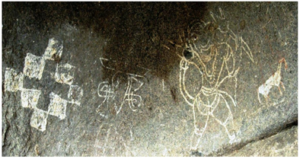Context:
Rudragiri hillock, unveils a fascinating combination of prehistoric rock paintings from the Mesolithic period and exquisite artwork from the Kakatiya dynasty
About Rudragiri Hillock:

- Location: Rudragiri Hillock is located amidst the Eastern Ghats.
- These served as living quarters for people during the Mesolithic age around 5000 B.C., and they bear witness to the luminous rock paintings of that era.
- Two natural caves are located at the southern end of the hillock which exhibit exceptional murals from the renowned Kakatiya kingdom.
- Murals are large-scale artworks that are typically painted or applied directly onto walls, ceilings, or other large surfaces.
- The first cave presents a narrative mural portraying the intense battle between the Vanara brothers, Vali and Sugriva.
- In the middle cave, a grand sketch of Hanuman, accompanied by sacred symbols of the conch (Sankha) and the fire altar (Yagna Vedi), captures visitors’ attention.

Image Credits: The Hindu
- The third cave houses the prehistoric rock paintings from the Mesolithic era.
- The Mesolithic Age, also known as the Middle Stone Age, was the second part of the Stone Age.
- Spread: Rajasthan, south of the river Krishna, central and eastern parts of India, and also in southern Uttar Pradesh.
- Time Period: In India, it spanned from 9,000 B.C. to 4,000 B.C.
- Characteristics:
- This age is characterized by the appearance of Microliths (small bladed stone tools).
- The Mesolithic Age was a transitional phase between the Paleolithic Age and the Neolithic Age.
- The people of this age lived on hunting, fishing, and food gathering; later on they also domesticated animals.
Post Views: 217
